Coin Values
This index features all the gold, silver, and other bullion coins issued by the US Mint from 1794 to 2010. It does not contain clad or copper coins commonly found in circulation. Although, at one time, many of these coins were in common trade. Now many are treasured as having intrinsic – due to their gold or silver content – and numismatic – due to age, condition and rarity, value. Each coin had received a dedicated page to provide the coin’s value and history to the investor or collector. Dive in and learn about these rare and beautiful masterpieces.
US Gold Coin Values & History
This section contains all the gold coins from 1796 to 1933. Explore the history of each coin and learn the current values of these rare and beautiful coins.
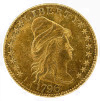 Draped Bust $2.5 Gold Coin (1796-1807)
Draped Bust $2.5 Gold Coin (1796-1807)
This gold coin was the result of the Coinage act of 1792 as the new government was forming. Designed by Robert Scot it is also called the Quarter Eagle or Turban Head. The $2.5 coin represented the weekly salary of the average working man.
Learn more about Draped Bust gold dollar coins from 1796-1807 here.
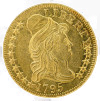 Draped Bust $5 Gold Coin (1795-1807)
Draped Bust $5 Gold Coin (1795-1807)
This gold coin was the result of the Coinage act of 1792 as the new government was forming. Designed by James B. Longacre it is also called the Half Eagle or Turban Head. The $5.00 Draped Bust was most used in business at the time.
Learn more about Draped Bust gold dollar coins from 1795-1807 here.
 Draped Bust $10 Gold Coin (1795-1804)
Draped Bust $10 Gold Coin (1795-1804)
This gold coin was the result of the Coinage act of 1792 as the new government was forming. Designed by James B. Longacre it is also called the Eagle or Turban Head. It was the flagship denomination which others were based on. It is one of the most rare of US coins now.
Learn more about Draped Bust gold dollar coins from 1795-1804 here.
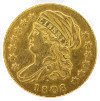 Capped Bust $2.5 Gold Coin (1808-1834)
Capped Bust $2.5 Gold Coin (1808-1834)
Designed by John Reich it is also called the “Capped Head to Left”. From the 1830’s to the Civil War, gold prices were high and gold coins were melted as bullion or sold internationally. Gold coins prior to 1834 are called “Old Tenor” because they have higher gold content and size then those minted after 1834.
Learn more about Capped Bust gold dollar coins from 1808-1834 here.
 Capped Bust $5 Gold Coin (1807-1834)
Capped Bust $5 Gold Coin (1807-1834)
Designed by John Reich it is also called the “Capped Head to Left”. From the 1830’s to the Civil War, gold prices were high and gold coins were melted as bullion or sold internationally. To keep the coins in circulation the Act of June 24 1834, lessened the gold content and the coin was made smaller. During the Civil War these coins were melted or sold internationally, making them very rare today.
Learn more about Capped Bust gold dollar coins from 1807-1834 here.
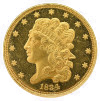 Classic Head $2.5 Gold Coin (1834-1839)
Classic Head $2.5 Gold Coin (1834-1839)
Designed by William Kneass it was minted in larger quantities than prior gold coins in several mints. This coin did not have “E PLURIBUS UNUM” on the reverse to immediately distinguish them from the earlier issues. Produced in high volume for the time, there are no distinct rarities. Though the 1838 C is the exception with a low mintage of 7880.
Learn more about Classic Head gold dollar coins from 1834-1839 here.
 Classic Head $5 Gold Coin (1834-1838)
Classic Head $5 Gold Coin (1834-1838)
Designed by William Kneass, this coin was minted in larger quantities than prior gold coins in several mints. The Act of 1834 call for a reduction in gold and size for gold coins. The weight was 8.36 grams, the purity was .8992 gold and .1008 silver and copper, the diameter was 22.5mm. In 1837 purity wa changed back to .900 by the Act of 1837.
Learn more about Classic Head gold dollar coins from 1834-1838 here.

Liberty Head $2.5 Gold Coin (1840-1907)
Designed by Christian Gobrecht, this coin was the longest continuous production of any design without a major change. It is also called the Coronet Head coin. Gold ore from the Charlotte and Dahlonega area had silver content which can be found in these coins up to 5%. These coins can have a greenish toning to them as they age. The 1848 CAL coin was made from the first gold to arrive in Philadelphia from the California Gold Rush.
Learn more about Liberty Head gold dollar coins from 1840-1907 here.
 Liberty Head $5 Gold Coin (1839-1908)
Liberty Head $5 Gold Coin (1839-1908)
Designed by Christian Gobrecht, this coin was the longest continuous production of any design without a major change. It is also called the Coronet Head coin. Gold ore from the Charlotte and Dahlonega area had silver content which can be found in these coins up to 5%. These coins can have a greenish toning to them as they age.The Half eagle is the only coin to be struck at all seven of the “traditional” U.S. mints.
Learn more about Liberty Head gold dollar coins from 1839-1908 here.
 Liberty Head $10 Gold Coin (1838-1907)
Liberty Head $10 Gold Coin (1838-1907)
Designed by Christian Gobrecht, this coin was the longest continuous production of any design without a major change. It is also called the Liberty Eagle or Coronet Head coin. The inspiration for the Gold Liberty Eagle design originated from two sources: the 1816 Coronet-type Large Cent for the obverse and the American eagle for the reverse. It is impossible to collect an uncirculated date set of Liberty Head $10 coins, as many years do not exist now.
Learn more about Liberty Head gold dollar coins from 1838-1907 here.
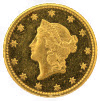 Liberty Head $20 Gold Coin (1850-1907)
Liberty Head $20 Gold Coin (1850-1907)
Designed by James B. Longacre, this coin was the first of its kind, and called a Double Eagle. Vast amounts of gold coming from California allowed this coin to be produced in large numbers. This coin facilitated large international transactions in a time when paper money was suspect.
Learn more about Liberty Head gold dollar coins from 1850-1907 here.
Gold Rush brings new coin! Gold was cheaper than silver so this $1 coin was authorized by Congress in 1848. Designed by James B. Longacre, prior to the civil war this coin was heavily used in day to day business. During the Civil War mintage was minimal and hoarding of gold and silver were rampant. The southern mints were closed in 1861 and only New Orleans reopened in 1870.
Learn more about gold dollar coins from 1849-1889 here.
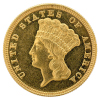 Three Dollar Gold Coin (1854-1889)
Three Dollar Gold Coin (1854-1889)
This coin was designed by James B. Longacre, and had a tie-in to postage. It was authorized so that a person could purchase 100 stamps with this coin. It is also called the Indian Princess Head coin. Longacre designed this coin as a truly American coin with the Indian Princess on the obverse and the agricultural wreath on the reverse. These coins were not popular and mintage after the civil war were very low.
Learn more about Three dollar gold coins from 1854-1889 here.
 Stella $4 Gold Coin (1879-1880)
Stella $4 Gold Coin (1879-1880)
This coin had two types, Type 1 was designed by Charles E. Barber and Type 2 was designed by George T. Morgan. This coin was a pattern (demo) proof coin to explore the possibility of joining the Latin Monetary Fund and have a coin set to international standards. Congress voted no to join the Latin Monetary fund and to this coin’s further production.
Learn more about Stella gold dollar coins from 1879-1880 here.
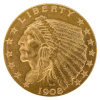 Indian Head $2.5 Gold Coin (1908-1929)
Indian Head $2.5 Gold Coin (1908-1929)
The “Indian Head” design and the similar half eagle piece were created by Boston sculptor Bela Lyon Pratt. The coin was a departure from other examples of American coinage because it had no raised edges, instead featuring a design sunk into the planchet. The public disliked the coins and thought it was ugly. This was the first coin to feature a realistic Native American image on a coin. This coin was frequently counterfeited, so buying uncertified coins can be risky.
Learn more about Indian Head gold dollar coins from 1908-1929 here.
 Indian Head $5 Gold Coin (1908-1929)
Indian Head $5 Gold Coin (1908-1929)
The $5 pieces, like their $2.50 counterparts, have the designs incuse, except for the mint marks on certain issues. Most of the 1929 coins were stored by the Treasury Department after mintage, were never released into circulation, and when gold coins were discontinued in 1933 they went to the melting pot.
Learn more about Indian Head gold dollar coins from 1908-1929 here.
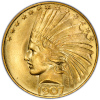 Indian Head $10 Gold Coin (1907-1933)
Indian Head $10 Gold Coin (1907-1933)
In 1904 President Teddy Roosevelt lobbied for more artistic designs from the mint. His friend Augustus Saint-Gaudens was brought in to design the new coins. He finished a draft of the Eagle and Double Eagle but died soon after. Charles Barber finished the Eagle so it could be released. The Double Eagle was never released.
Learn more about Indian Head gold dollar coins from 1907-1933 here.
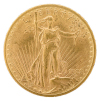 Saint Gaudens $20 Gold Coin (1907-1933)
Saint Gaudens $20 Gold Coin (1907-1933)
In 1904 President Teddy Roosevelt lobbied for more artistic designs from the mint. His friend Augustus Saint-Gaudens was brought in to design the new coins. The initial Saint-Gaudens design was struck in high relief. But this coin could not be used in the high speed presses, it was redesigned to a lower relief. In 1940 it was illegal to own one, except for King Farouk of Egypt. His coin went to auction in 2002 is the highest coin ever sold at $7,590,020.
Learn more about Saint Gaudens gold dollar coins from 1907-1933 here.
US Bullion Coin Values & History
This section contains all the Bullion Coins from 1986 to the present. Bullion coin are made for investors and collectors and have many international competitors. Explore the variety and designs below, while learning the value they can provide to your portfolio.
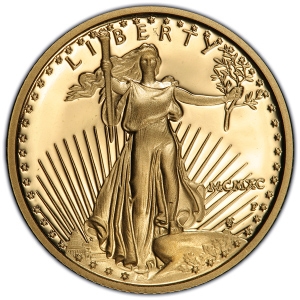 Gold Eagles $5, $10, $25, $50 (1986-Present)
Gold Eagles $5, $10, $25, $50 (1986-Present)
The US Gold Eagle comes in four denominations, each identical in design; Gold Eagle $5, Gold Eagle $10, Gold Eagle $25 and the Gold Eagle $50. Starting in 1986 the US Mint start making Gold Bullion coins to compete with the international bullion coin market. The Krugerrand and Maple Leaf coins were very popular and were bringing in a tremendous about of revenue for their governments.
Learn more about Gold Eagle coins by clicking the coin link.
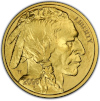 Gold Buffaloes $5, $10, $25, $50 (2008)
Gold Buffaloes $5, $10, $25, $50 (2008)
The US Gold Buffalo comes in four denominations, each identical in design; Gold Buffalo $5, Gold Buffalo $10, Gold Buffalo $25 and the Gold Buffalo $50. The Gold Buffalo coin was issued in response to a high demand for a pure gold coin (99.99%) vs. the Gold Eagle (99.93%) coin. The design is the same as the James Earle Fraser’s “Buffalo Nickel” (issued from 1913 to 1938). The only difference between the two coins is the motto “In God We Trust” on the reverse.
Learn more about Gold Buffalo coin by clicking the coin link.
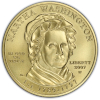 Gold First Spouses $10 (2007-2016)
Gold First Spouses $10 (2007-2016)
The US Congress commissioned Copper 1$ coins to honor the US Presidents and Gold $10 coins to honor the First Spouses with the 2005 Presidential $1 Coin Act. These coins sold well early, and became less popular as the price of Gold rose. A Barbara Bush coin will be issued in 2020. To qualify to have the coin made the president must be deceased 2 years.
Learn more about Gold First Spouses coins here.
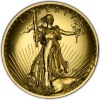 Gold Ultra High Relief Double Eagle $20 (2009)
Gold Ultra High Relief Double Eagle $20 (2009)
The 2009 Ultra-High Relief was a reprise of the extremely rare, double-thick, small diameter pattern coin proposed by Augustus Saint-Gaudens in 1907. These coins have been very popular with collectors and though a Bullion coin the mint sold them with a premium to the price of gold. Some were melted when the price of gold spiked, but the coins have regained their popularity and melting has ceased.
Learn more about Gold Ultra High Relief Double Eagle coins here.
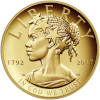 Gold High Relief American Liberty $100 (2015-Present)
Gold High Relief American Liberty $100 (2015-Present)
This is the first $100 face value coin. The coins are struck at the West Point Mint on a 1 oz. 24 karat gold planchet. Each odd year a new design will be featured. Designs for the American Liberty coins are submitted to the US Mint via the Artistic Infusion Program.
Learn more about Gold High Relief American Liberty coins here.
Silver Eagle $1 (1986-Present)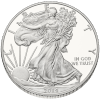
Silver has historically been the most affordable precious metal. Starting in 1986 the US Mint start making Silver Bullion coins to compete with the very popular Canadian Maple Leaf, Chinese Panda’s and other international bullion coins. They are the only silver coins allowed in an IRA.
Learn more about Silver Eagle dollar coins here.
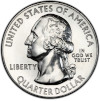 Silver America the Beautiful 5oz (2010-Present)
Silver America the Beautiful 5oz (2010-Present)
These 5oz silver coins copy the designs of the “America the Beautiful” quarters. The coins are three inches in diameter and have a face value of 25 cents. These are the first five ounce, three inch, .999 fine silver bullion coins ever produced by the United States Mint.
Learn more about America the Beautiful silver dollar coins here.
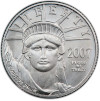 Platinum Eagle $10, $25, $50, $100 (1997-Present)
Platinum Eagle $10, $25, $50, $100 (1997-Present)
The US Platinum Eagle comes in four denominations, each identical in design; Platinum Eagle $10, Platinum Eagle $25, Platinum Eagle $50, and the Platinum Eagle $100. In 1997, the United States began striking platinum coins to compete with other world bullion coins. This is the first coin to portray an realistic image of the Statue of Liberty. Each year offers a new reverse design on the proof coins.
Learn more about Platinum Eagle coins by clicking the coin link.
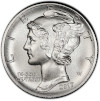 Palladium Eagle $25 (2017-Present)
Palladium Eagle $25 (2017-Present)
In 2017 the U.S. Mint introduced its first bullion coin struck in palladium. For the obverse of the coin, the U.S. Mint chose Adolph A. Weinman’s Winged Liberty design used on Mercury Dimes from 1916-1945. The reverse of the 2017 Palladium coins feature a high relief version of the 1907 American Institute of Architects gold medal.
Learn more about Palladium Eagle coins here.
US Silver Coin Values & History
This section contains all the Silver Coins from 1794 to 1963. Explore the history and variety of designs while learning the value of these coins to collectors.
Three-Cents
In 1850 it was felt there was a need for a coin between the cent and a Half Dime and also postage had been recently changed to three cents. This coin also was used to convert the Spanish Riel (used in trade), to a US coin, thereby eliminating the Riel from US circulation. Unlike other coins produced for circulation at the time, the design lacked a visual representation of Liberty.
Learn more about Three Cent Silver coins from 1851-1873 here.
Half Dimes
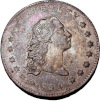 Flowing Hair Half Dime (1794–1795)
Flowing Hair Half Dime (1794–1795)
The Flowing Hair Half Dime design was the same as the dollar. The design was not popular and was only minted for two years. The designation of denomination or value does not appear on either side of this coin.
Learn more about Flowing Hair Half Dime coins from 1794-1795 here.
 Draped Bust Half Dime (1796-1805)
Draped Bust Half Dime (1796-1805)
This coin was minted from 1796-1803 and 1805 and is the same design as the dollar. Robert Scott designed the front from a portrait, believed to be Ann Willing Bingham a popular socialite in Philadelphia. The only way to tell the denomination or value was by this coin’s size.
Learn more about Draped Bust Half Dime coins from 1796-1805 here.
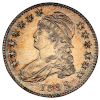 Capped Bust Half Dime (1829–1837)
Capped Bust Half Dime (1829–1837)
There were no Half Dimes minted between 1807 and 1828. In 1829 the Capped Bust design was chosen for Half Dimes. John Reich designed the Capped Bust, and it was modified by Mint Engraver, William Kneass. There were many variations for the Capped Bust Half Dime in its 8 year run, including proof strikes in several years.
Learn more about Capped Bust Half Dime coins from 1829-1837 here.
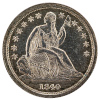 Seated Liberty Half Dime (1837-1873)
Seated Liberty Half Dime (1837-1873)
The Seated Liberty design was used on all the silver denominations including the Half Dime. Christian Gobrecht was the new mint engraver, Thomas Sully and Titian Peale designed the coin. The first minting was dated 1837 and continued till 1873. There are five Coin Types.
Learn more about Seated Liberty Dime coins from 1837-1873 here.
Dimes
Disme is the French word for tenth. The Coinage Act of 1792 authorized the mintage of a “disme”, one-tenth the silver weight and value of a dollar. The composition of the Disme was set at 89.24% silver and 10.76% copper. The first of these were struck in copper, as pattern coins. Only 3 are known today and they are copper.
Learn more about Disme coins from 1792 here.
This coin was minted from 1796 to 1807 and is the same design as the dollar. Robert Scott designed the front from a portrait, believed to be Ann Willing Bingham a popular socialite in Philadelphia. The quality of these coins suffered many mint problems.
Learn more about Draped Bust Dime coins from 1796-1807 here.
John Reich designed the Capped Bust, and it was modified by Mint Engraver, William Kneass. There are 2 design Types for this coin. The Type 1, Large Dentils (1809-1828), and the Type 2, Small Dentils (1828-1837). Dentrils are the bumps on the inner rim of obverse and reverse. On the Type 2 coin the diameter of the coin was 1mm smaller and the bumps were closer together.
Learn more about Capped Bust Dime coins from 1809-1837 here.
 Seated Liberty Dimes (1837-1891)
Seated Liberty Dimes (1837-1891)
The Seated Liberty design was used on all the silver denominations including the Dime for this program. Christian Gobrecht was the new mint engraver, Thomas Sully and Titian Peale designed the coin. The first minting was dated 1837 and continued till 1891. This coin had 6 design changes or 6 Types. Collecting them all is challenging.
Learn more about Seated Liberty Dime coins from 1837-1891 here.
By the end of the 19th century the public was tired of the Seated Liberty designs, calling them ugly and boring. In 1891 congress passed the authorization of a new design. A contest for Artists was set up, but no design was deemed worthy. So Charles E. Barber, the mint engraver, designed the coin. The dime, quarter and half dollar all feature the same design, except the dime does not have stars on the reverse.
Learn more about Barber Dime coins from 1892-1916 here.
The Mercury design was used only on the Dime. In 1890 congress passed a Bill that ceded control over coin design changes to the Secretary of the Treasury and the Mint, but designs could only change every 25 years. The coin was designed by Adolph A Weinman. The first minting was dated 1916 and continued till 1945. The Roman themed design and the resemblance to the god Mercury gave this coin it’s nickname.
Learn more about Mercury Dime coins from 1916-1945 here.
Franklin Delano Roosevelt was a very popular president and the Roosevelt Dime was authorized to honor him after he died in 1945. John R. Sinnock designed the coin, the first minting was 1946 in silver till 1964 and continues still today as clad. Silver proof Dimes can be found in the annual Silver Proof Sets (1968-present).
Learn more about Roosevelt Dime coins from 1946-1964 here.
Quarters
 Draped Bust Quarter (1796–1807)
Draped Bust Quarter (1796–1807)
For collectors the 1796 Quarter is a landmark in American Coins. This coin was minted from 1796 then 1804- 1807 and is the same design as the dollar. The 1804 Heraldic Eagle reverse introduced a national motto – E pluribus unum
Learn more about Draped Bust Quarter coins from 1796-1807 here.
 Capped Bust Quarter (1815–1838)
Capped Bust Quarter (1815–1838)
Quarters were not made from 1807-1814. The public demanded to have them, production began in 1815 this coin. Again in 1828-1830 production ceased. They came back in 1831 with a smaller diameter and a slight design change.
Learn more about Capped Bust Quarter coins from 1815-1838 here.
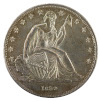 Seated Liberty Quarter (1838-1891)
Seated Liberty Quarter (1838-1891)
The Seated Liberty design was used on all the silver denominations including the Quarter. Thomas Sully and Titian Peale designed the coin. The first minting was dated 1839 and continued till 1891.This coin has 6 Types. Collecting them all is challenging.
Learn more about Seated Liberty Quarter coins from 1838-1891 here.
By the end of the 19th century the public was tired of the Seated Liberty designs, calling them ugly and boring. In 1891 congress passed the authorization of a new design. A contest for Artists was set up, but no design was deemed worthy. So Charles E. Barber, the mint engraver, designed the coin. The dime, quarter and half dollar all feature the same design.
Learn more about Barber Quarter coins from 1892-1916 here.
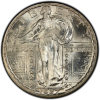 Standing Liberty Quarter (1916-1930)
Standing Liberty Quarter (1916-1930)
The Standing Liberty design was only used on the quarter to replace the Barber design. Hermon A. MacNeil designed the coin and it went through several drafts prior to minting. The initial design of this coin was a bare-breasted Liberty. The design was approved when chainmail was added to cover her chest. The first minting was 1916 and continued till 1930 although no quarters were minted in 1922. There were many problems with excessive wearing of the date and head.
Learn more about Standing Liberty Quarter coins from 1916-1930 here.
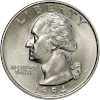 Washington Quarter (1932-1964)
Washington Quarter (1932-1964)
A congressional committee was formed for the bicentennial of George Washington’s birth. They wanted to honor him with a coin and at first selected the Half Dollar, but then settled for the quarter because of the minting problems with the Standing Liberty Quarter. The first minting was dated 1932 and continued in silver till 1964. Bicentennial silver coins were minted in 1996. Since 1999 the reverse of the washington quarter has commemorated the 50 states (1999-2008 ), Washington DC and Territories (2009 ), and the National Parks (2010-2021). All these commemorative quarters can be found in silver as part of the annual Silver Proof Sets and are very popular for collectors.
Learn more about Washington Quarter coins from 1932-1964 here.
Half Dollars
 Flowing Hair Half Dollar (1794–1795)
Flowing Hair Half Dollar (1794–1795)
Half dollars of 1794-1795 have the same design as the half dimes and silver dollars. All of these coins were sent into circulation, hence the wear and condition of all these coins is fine or lower.
Learn more about standing Flowing Hair Half Dollar coins from 1794-1795 here.
 Draped Bust Half Dollar (1796–1807)
Draped Bust Half Dollar (1796–1807)
In 1796, Congress responded with universal dissatisfaction of the first coins (Flowing Hair dollar) and decreed a new design. By Congressional decree, certain features were required: the eagle, the word stars, Liberty, and United States of America. There is no denomination mark on the coin, the only way to tell is by size.
Learn more about Draped Bust Half Dollar coins from 1796-1807 here.
 Capped Bust Half Dollar (1807–1839)
Capped Bust Half Dollar (1807–1839)
John Reich designed the Capped Bust, and it was modified by Mint Engraver, William Kneass. In 1836 steam powered pressed came to the Philadelphia mint, this allowed more detailed dies and faster production.
Learn more about Capped Bust Half Dollar coins from 1807-1839 here.
 Seated Liberty Half Dollar (1839-1891)
Seated Liberty Half Dollar (1839-1891)
The Seated Liberty design was used on all the silver denominations including the Half Dollar. Christian Gobrecht was the new mint engraver designed the coin with Thomas Sully. The first minting was dated 1839 and continued till 1891. This coin had 6 design changes or 6 Types. Collecting them all is challenging.
Learn more about Seated Liberty Half Dollar coins from 1839-1891 here.
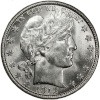 Barber Half Dollar (1892-1915)
Barber Half Dollar (1892-1915)
The Barber design was used on the Dime, Quarter and Half Dollar. By the end of the 19th century the public was tired of the Seated Liberty designs, calling them ugly and boring. In 1891 congress passed the authorization of a new design. A contest for Artists was set up, but no design was deemed worthy. So Charles E. Barber, the mint engraver, designed the coin. The first minting was dated 1892 and continued till 1915.
Learn more about Barber Half Dollar coins from 1892-1915 here.
 Walking Liberty Half Dollar (1916-1947)
Walking Liberty Half Dollar (1916-1947)
In 1915 the Mint Director, Robert Woolley started the process of replacing the Barber coins at the end of their 25 year run. A competition was held in which engraver Charles Barber submitted a design. Barber’s design was not chosen, but that of Adolph A. Weinman a well known sculptor. As Head engraver, Barber did what he could to delay the release of the coin. The first 2 years the mint mark was on the obverse, then moved to reverse.
Learn more about Walking Liberty Half Dollar coins from 1916-1947 here.
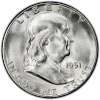 Franklin Half Dollar (1948-1963)
Franklin Half Dollar (1948-1963)
Mint Director Nellie Ross, had greatly admired Benjamin Franklin and wanted to honor him on a coin. She directed Engraver John Sinnock to design a half dollar. Sinnock died before completion and Gilroy Roberts finished the design for minting.The first coins were criticized for it’s plain design compared to the Walking Liberty. Over time an appreciation has developed for its simplicity.
Learn more about Franklin Half Dollar coins from 1948-1963 here.
Silver Dollars
 Flowing Hair Dollar (1794-1795)
Flowing Hair Dollar (1794-1795)
The 1792 Coinage Act required a Liberty on the front and an Eagles on the back. The first Mint Engraver, Robert Scot designed the coin. Only about 200 1794 coins exist now. All of these coins were sent into circulation, hence the wear and condition of all these coins is fine or lower. The designation of denomination or value does not appear on either side of this coin.
Learn more about Flowing Hair Dollar coins from 1796-1795 here.
 Draped Bust Dollar (1795-1804)
Draped Bust Dollar (1795-1804)
Artist Gilbert Stuart is believed to be the designer of the Draped Bust Dollar. George Washington and Thomas Jefferson approved the design. Among silver dollars the Type 1, draped bust with small eagle reverse is the most rare. This coin was minted from 1795 to 1803. It was later reproduced in the 1850’s with a date of 1804.
Learn more about Draped Bust Dollar coins from 1795-1804 here.
 Seated Liberty Dollar (1836-1873)
Seated Liberty Dollar (1836-1873)
Silver Dollars stopped being minted after 1803 due to a lack of bullion and the need for smaller denominations. In 1835, the mint received a large supply of bullion and decided to mint a small amount of silver dollars to gauge interest. Christian Gobrecht was the new mint engraver, Thomas Sully and Titian Peale designed the coin. In 1840, larger more consistent amounts of bullion became available and large quantities of silver dollars were minted.
Learn more about standing Seated Liberty Dollar coins from 1836-1873 here.
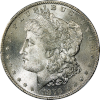 Morgan Silver Dollar (1878-1921)
Morgan Silver Dollar (1878-1921)
With the demonetization of silver in 1873, there were no silver dollars from 1873-1878. The Bland-Allison Act of 1878 was passed due to lobbying pressure from western miners. The Bland-Allison Act stated that the mint must purchase silver from US mines and produce silver dollars. A new dollar was designed by George T Morgan, hence the name Morgan Dollar. Morgan dollars have been a favorite of collectors, because of the design, the amount minted and the affordability.
Learn more about Morgan Silver Dollar coins from 1878-1921 here.
While most announcement articles of the 1921 Peace Dollar describe the coin as a tribute the end of World War I, there is a deeper history for the need of this coin. It started in India in 1917 when German propaganda was spread that the British pound notes could not be redeemed by sterling. It caused a run on the banks in India and England for most of the British sterling. England was facing a financial crisis and asked the US for assistance. The Pittman Act of 1918 was the US Response. The Pittman Act had several provisions among them, the mint should melt up to 350 million silver dollars and that bullion was sold to England for $1 per troy ounce, and coins should be minted after the war to replace those melted. Morgan coins were minted first, but Numismatists started a campaign to lobby congress to produce a coin that was a tribute to the Victory of WWI. An artistic competition was held for the design and Anthony de Francisci’s design was chosen. He used is wife Teresa, as the model. The coin was minted from 1921-1928 and then again in 1934-1935.
Learn more about Peace Dollar Coins from 1921-1935 here.

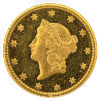
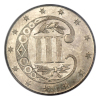 Three Cent Silver (1851-1873)
Three Cent Silver (1851-1873)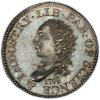
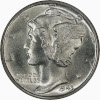 Mercury Dime (1916-1945)
Mercury Dime (1916-1945) Roosevelt Dime (1946-1964)
Roosevelt Dime (1946-1964)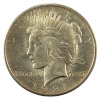 Peace Dollars (1921-1935)
Peace Dollars (1921-1935)